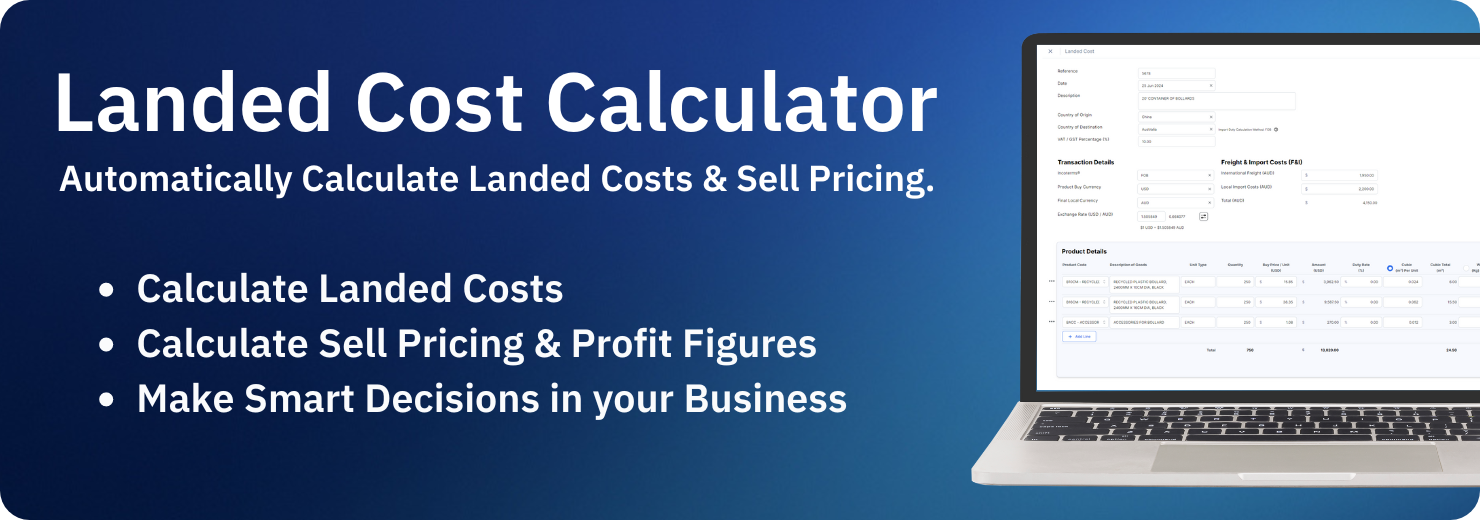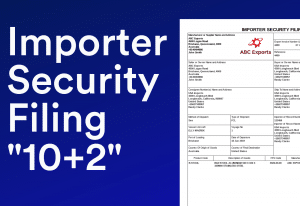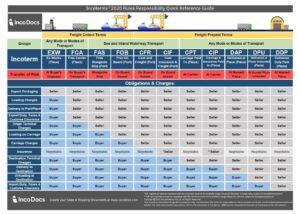Businesses that are involved in Global Trade are faced with dozens of additional costs, fees and charges involved with importing products through to the final location. It’s imperative that buyers understand the total landed cost of imported products in advance, to make informed and smart decisions for their business.
What is a landed cost?
A ‘landed cost’ is the term used when referring to the final cost of products plus all associated shipping and logistics costs required to get the goods delivered through to a final location. Throughout the global trade process there can be dozens of additional charges, fees and currency conversions that buyers must be aware of in advance so that the landed cost of the products can be calculated.
Some of the import costs within the supply chain include the cost of the products, currency conversion costs, international freight & logistics charges, import charges, port charges, tariffs, harbor fees, handling fees, customs clearance fees, import and export duties & taxes, payment processing fee and local delivery, to name a few.
Why is a landed cost calculation important?
Businesses must have a good understanding of what the landed cost of imported products will be in advance so that they can make smart decisions for their business. If a business is planning to import products and on-sell them in their market, then they must have a good idea of what the actual final landed cost is for each item.
Understanding the landed cost of a products allows business to plan how much capital will have to be invested to purchase products and get them delivered through to location. On top of that, it also helps businesses to plan their sell prices and profit margin figures that will eventuate when the products are sold.
If businesses do not take the time to understand their landed cost, they could be faced with unexpected fees and charges which could make importing the products unviable. Calculating the landed cost requires an understanding of some key costs associated and correctly applying them to each product to get the final landed cost per unit.
 Use the Landed Cost Calculator
Use the Landed Cost CalculatorHow to calculate the landed cost of imported products.
Firstly, it’s important to understand all of the different costs, fees and charges involved throughout the purchasing and importing process. Below is a list of information that you will need to know to accurately calculate the landed cost of imported products.
Step 1: Receive a detailed quotation from the exporter. The quotation will include the following details:
- Shipper & Consignee’s details
- Incoterm® & Place
- Port of Loading (POL) & Port of Discharge (POD)
- Currency (most commonly USD)
- Product details and pricing
- Product HS/HTS Codes
- Product and packaging sizes
- Shipment type (by Full Container – FCL, or Less-than-Container-Load LCL Cargo).
Step 2: Understand the international shipping costs, including freight and additional import charges.
You can contact a freight forwarder to get a confirmed quotation to get products shipped through to your location. Most global trade shipments are sold on the FOB Incoterm® (Free-On-Board) which means that the consignee (buyer) will pay for all additional costs and charges after the goods have been loaded on board the vessel for export.
A freight forwarder’s quote will usually be itemized to show all of the fees involved. This includes:
- International Seafreight from Port of Loading to Port of Discharge (usually in USD) – Note seafreight and airfreight rates vary throughout the year so you will have to confirm the validity date.
- Local charges in the country of import (get these costs in your local currency) – These include local port handling costs, documentation, customs duties, quarantine, marine transit insurance, domestic trucking etc.
- Local Import Duty Rates – If you supply the HS Code for the goods to import, the freight forwarder or customs broker can confirm what rate of duties will be applied to the imported goods. Also, confirm how the import duty is charged on your product. This process varies from country to country so get confirmation for your situation.
- Import Taxes – Understand the local tax rate (VAT/GST) and how it is applied to imported goods.
Step 3: Understand the actual foreign currency exchange rates and costs.
There are plenty of options to make foreign exchange payments to International suppliers. You must clearly understand the actual exchange rate that your Currency Exchange provider can offer you. Note that the exchange rate that you secure will be less than the current interbank rate.
Read more about SWIFT Telegraphic Transfers (T/T) and other International payment methods.
An Example of how to Calculate the Landed Cost of Imported Products
In this example, we’ll be applying the landed cost formula. Let’s look at a basic example of a shipment of a 20’ container of goods from China. A supplier has quoted:
- 100pcs of furniture items – $100 USD per piece
- Incoterm® – FOB, Shanghai Port
- Total FOB Cost – $10,000 USD
- Shipment Type – 20′ GP Container
- HS Code – 1234.56
Step 1: Convert all foreign currencies into your local currency (taking into account your actual exchange rates that will be secured when making International T/T payments). You will most likely have to convert the supplier’s USD costs and the International Seafreight charges into your local currency. When you have converted all foreign currencies into your local currency, add all of the costs together.
- Product FOB $10,000USD = $13,000 in your local currency
- Seafreight $2,000USD = $2,600 in your local currency
- TOTAL Product + Seafreight = $15,600 local currency
Step 2: Add all local import costs and charges from the freight forwarder, in this example $1500:
- ADD $1,500 (in your local currency)
Step 3 – Calculate Import Duty Charges
NOTE: Import duty and import tax rates vary from country to country. There are 2 main valuation methods that countries use to charge import duties and taxes, on either the FOB or CIF value of the goods.
FOB: The Import duty is charged on the “Free On Board” value of the products. i.e. duty is charged on the FOB value of goods (on the currency of the importing country).
CIF: The Import duty is charged on the “Cost, Insurance and Freight” value of the products. So duty will be charged on the cost of the products + cost of insurance (if any) + cost of International transport through to the port of discharge (on the currency of the importing country).
In this example, the freight forwarder has confirmed that a 5% import duty rate will apply to the FOB value of imported goods (local currency). So 5% import duty will be charged on $13,000 ($650):
- ADD $650 in import duty charges
Step 4: Add import taxes. In this example 10% import tax is charged on the final value of imported goods (final value $17,750):
- ADD $1,775 import taxes
So the final landed cost of goods imported into country:
- FOB $13,000
- + Seafreight $2,600
- + All local import costs $1,500
- + 5% import duty $650
Total Landed Cost = $17,750 + 10% Tax of $1,775
Next, split up the charges to calculate the landed cost per product.
Most import shipments contain multiple items inside 1 shipment, so you will have to calculate the landed cost per product (per unit). You can split up all of the additional costs by cubic volume (m3), or by weight, usually whatever is greater.
To do this you will need to accurately understand the packaging sizes and weight of each product and split up the costs per product/unit. The easiest way to do this is to calculate the cubic measurement (m3) per product/unit or weight (kg) per product/unit. The totals of all of the costs ($17,750 in the above example), i.e. the FOB Costs (local currency) + the International freight costs + local import costs + 5% import duty can then be split up by the cubic measurement or weight (whatever is greater).
From the example above, the total landed cost amounts to $17,750 (excluding taxes). So the next step is to determine the unit cost for each imported item. In this example calculation, the total landed cost is divided by the total quantity of furniture items (100pcs) which will calculate the landed cost per product/unit (Excluding Taxes):
Total Landed Cost Per Unit = Total Landed Cost / Number
Total Landed Cost Per Unit = $17,750 / 100
Total Landed Cost Per Unit = $177.50 (Ex. Taxes)
TIP: We have various free tools including CBM Calculators that can help with calculating the landed costs.
How to apply markup and margin to calculate sell pricing.
If importers are onselling the products in their business, they will have to add a markup or margin on top of the landed costs, to work out their sell pricing, i.e. how much these products can be sold for in the market. This will give businesses a good understanding of the profit margins that can be made and gives an insight into the return on investment (ROI) if they were to import and on-sell the products.
To work out sell pricing, importers can apply a markup or margin percentage to the cost price. It’s important to note that markup and margin are 2 completely different methods of calculations which must not get confused. Read more about Markup Vs Margin here.
How to place orders with International suppliers
Once businesses understand the landed cost of the products to be be imported, they can decide to place a new order. Importers can place new orders with International suppliers by sending an official Purchase Order document. Read more on how Purchase Order and Proforma Invoices work here.
How to use a Landed Cost calculator to work out landed costs and sell pricing.
Calculating the landed cost per item can be a long, time consuming process. On top of that, if you make any mistakes in the calculations then your projections could be well under or over the actual charges.
To support importers and exporters during the landed cost process, our team created a simple to use Landed Cost Excel Calculator. This landed cost calculator allows buyers and sellers to:
- Calculate landed costs broken down per product
- Calculate landed costs by Cubic Volume (m3), or weight
- Add markup or margin to each product to calculate sell pricing and profit figures
 Use the Landed Cost Calculator
Use the Landed Cost Calculator






